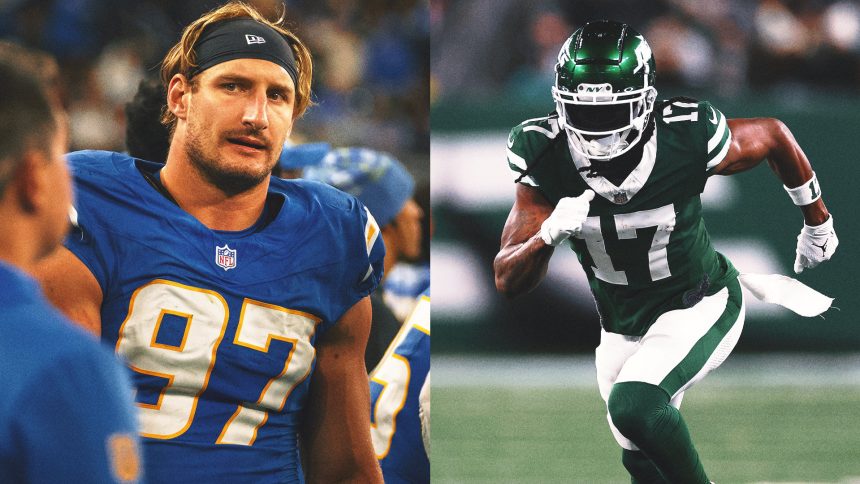The NFL‘s salary cap will be on the rise again in 2025, but that doesn’t mean everyone will benefit from it when free agency opens in March.
As of Wednesday, five teams are still projected to be above the salary cap for 2025 when the new league year begins, while several others might need to clear cap space in order to re-sign their own players, sign their draft picks or make any major additions this offseason.
Oftentimes, the easiest way for franchises to do that is to cut ties with one of their highest-paid players. As some teams are positioning to maximize their cap space ahead of free agency, here are the 10 most notable players who might be moved this offseason due to their cap number, with all salary figures coming via OverTheCap.com.
ADVERTISEMENT
Bosa’s time with the Chargers appears prime to end after nine seasons. Los Angeles is likely to cut its standout defensive end before he’s due a $12.36 million signing bonus in March, ESPN reported Wednesday.
If the Chargers wind up doing that, they’ll be parting with one of their top players over the last decade. Bosa was named to his fifth Pro Bowl in 2024, but the 29-year-old has missed 23 games over the last three seasons due to multiple injuries.
Still, Bosa has been productive. He had 22 total tackles, five sacks and two forced fumbles in 2024 to go with a 13.9% pass-rush win rate, per Pro Football Focus, which ranked 39th in the league among all defenders who played at least 20% of their team’s snaps.
However, those numbers aren’t strong enough to command the $36.5 million cap hit he’ll have for 2024. Even though the Chargers have roughly $70 million in cap room, releasing Bosa would still open up $25.4 million as they look to build off their playoff appearance in 2024.
A year after signing Cousins to a four-year, $180 million deal with $100 million guaranteed, the Falcons could make the decision to move on from the veteran fact. In fact, they’re expected to do so, ESPN reported in December.
Cousins’ release wouldn’t create immediate cap space for the Falcons, but it would help them save some money. Cousins is already guaranteed $27.5 million for the 2025 season and is due a $10 million roster bonus when the new league year opens on March 12. The Falcons would be stuck with $65 million in dead money if they released Cousins and would lose $25 million in cap space if they did so with a pre-June 1 designation. However, the Falcons can spread the dead money out if they release him with a post-June 1 designation, eating $40 million in 2025 and $25 million in 2026.
The latter might be the more tenable option for Atlanta. The Falcons are nearly $5 million above the projected salary cap and releasing Cousins with a post-June 1 designation wouldn’t come with a hit against their cap space for 2025.
Cousins, who’ll be 37 when the 2025 season opens, notably struggled down the stretch last season, finishing the year with 3,508 passing yards, 18 touchdowns and 16 interceptions before being benched for rookie Michael Penix Jr. for the final three games of the season.
The Jets have already announced that they’re moving on from Aaron Rodgers, sharing that they’ll release him later this offseason. They could also move on from his favorite target, too.
Adams is also expected to be released ahead of the start of the new league year, ESPN previously reported. The star wideout has a whopping $38.3 million cap hit for the 2025 season as a result of the contract restructuring he did following his trade to New York. But none of that money is guaranteed, and the Jets would clear almost $30 million ($29.89 million, more precisely) if they release him with a pre-June 1 designation.
New York could certainly use the cap relief. It’s projected to have around $24 million in general manager Darren Mougey’s and head coach Aaron Glenn’s first offseason together.
Adams was still a weapon in 2024 even though he’s set to be released, recording 85 receptions for 1,063 yards and eight touchdowns over 14 games between the Jets and Las Vegas Raiders. It marked the fifth straight year that Adams reached the 1,000-yard mark.
Adams’ old friend from college and the Raiders could also hit the open market for the second time in three years.
Carr is a possible cut candidate as the Saints usher in a new era under Kellen Moore. The new head coach was complimentary of Carr during his introductory press conference, calling him a “tremendous starting quarterback,” but didn’t commit to whether the 33-year-old would be the Saints’ long-term quarterback.
Carr’s contract is one of the biggest hurdles in the Saints’ path to becoming cap compliant. He has a $51.5 million cap hit for the 2025 season and the Saints are roughly $47 million above the cap. Releasing Carr would be one of the easiest ways, though, for New Orleans to create cap room. He already has $10 million guaranteed for 2025 and a $30 million base salary that becomes fully guaranteed three days into the new league year. If the Saints release Carr with a post-June 1 designation, they would yield $30 million in cap space and spread his dead cap hit over two years ($21.5 million in 2025, $28.7 million in 2026).
Carr told ESPN in January that he isn’t willing to take a pay cut in order to remain in New Orleans, potentially adding to the likelihood that he gets released. He had a solid stat line in 2024 (2,145 passing yards, 15 passing touchdowns, five interceptions, 101 passer rating), but he missed seven games due to multiple injuries and went 5-5 in the 10 games he started.
Kupp has already said that the Rams plan to trade him, but there’s the possibility he could get released, too. There was some speculation that he revealed that news in order to crash his trade market.
If the Rams aren’t able to trade him, they’ll still stand to benefit from a cap standpoint if they release the 31-year-old. If Kupp is cut with a pre-June 1 designation, the Rams will save $7.5 million in cap space, though they’d also take on a $22.3 million cap hit. If they released him with a post-June 1 designation, the Rams would clear $15 million in cap space and take on $14.8 million in dead money. That’s actually more money than what they’d save in cap space if they traded him ($12.5 million).
The Rams have approximately $44 million in cap space available for the 2025 season, so it isn’t imperative to move Kupp. But they’ve already signaled that they’re done with him.
The Bills are sitting at $10.1 million above the cap line a few weeks before free agency. Doing something with Miller’s contract is the simplest way to help them get under it.
Miller has a $23.8 million cap hit for 2025, which is the second-largest number on the team. But the question is whether they release him or can get him to agree to a pay cut. A release with a pre-June 1 designation would clear $8.4 million in cap space for the Bills, but they’d take on a $15.4 million dead cap hit. If they release him with a post-June 1 designation, the dead cap hit would be far lower ($6.4 million) than the amount of cap space they made ($17.4 million).
Miller, who’ll turn 36 in March, only played in 33% of the Bills’ defensive snaps in 2024, so that cap number is pretty disproportionate compared to the role he had. However, he remained an effective pass rusher, recording six sacks and 32 pressures to go with 17 total tackles in 13 games last season.
The Jaguars aren’t in desperate need to dump salary this offseason, with just over $38 million in cap space. However, it’s clear they need more help after a four-win season in 2024, and cutting Kirk would open up more cap room for them.
If the Jaguars release Kirk with a pre-June 1 designation, they’d create $10.4 million in cap space with a $13.7 million dead cap hit. If they released him with a post-June 1 cut designation, they would create $16.2 million in cap space with a $7.9 million hit.
Kirk, 28, was productive early on in his Jaguars tenure, but he’s become a bit more expendable following the emergence of Brian Thomas Jr. to go with last offseason’s signing of Gabe Davis. Additionally, he’s missed several games over the last two seasons due to core and collarbone injuries, and his $24 million cap hit is the highest on the team. However, none of the money is guaranteed.
One of the Commanders’ defensive leaders is another prime cut candidate even though Washington has more than $80 million in cap space.
If the Commanders release Allen, they’d create $16.5 million in cap space and only eat $6 million in dead cap. Even though the Commanders will likely gear up for a title run after their impressive 2024 season, there are a few other reasons why Allen could be on the chopping block beyond the salary savings. His $22.5 million cap hit is the third-highest on the team and the Commanders have already made a major financial commitment to defensive tackle Daron Payne while picking defensive tackle Jer’Zhan Newton in the second round of the 2024 draft.
Additionally, Allen’s production has gone down in the last few seasons. He recorded three sacks and 19 total tackles while playing in just eight games in 2024 due to a pec tear. As Allen is owed zero guaranteed money in 2025, using his cap space on other players might be the best way for the Commanders to maximize their resources as they seek to make a run with Jayden Daniels still on his rookie contract.
The Eagles have quite a few impending free agents. If they want to keep at least two of linebacker Zack Baun, edge rusher Josh Sweat, defensive tackle Milton Williams and guard Mekhi Becton, they’ll have to shed some salary. They’re projected to have between $19-20 million in cap space this offseason.
So, a player like Slay might be on the move. The 34-year-old’s $13.7 million cap hit is the fifth-highest on the team in 2025. However, if the Eagles opted to say goodbye to Slay, it would almost certainly have to be with a post-June 1 designation. They would lose $8.9 million in cap space if they released him with a pre-June 1 designation, but would clear $4.3 million if they released him with a post-June 1 designation. Releasing him with a post-June 1 designation would also create $17.8 million in cap space in 2026.
Similar to Allen, Slay has also become more expendable due to his decline in play, recent injuries and the players around him. He only had one interception in the regular season and postseason combined, tying his second-fewest total in a season. He also missed time with a groin injury and a concussion in 2024 as rookie corners Quinyon Mitchell and Cooper DeJean played a major role in Philadelphia’s Super Bowl win.
Lockett still made an impact for the Seahawks in 2024 and is the longest-tenured player on the team, but it would make sense for Seattle to part ways with him this offseason.
The veteran wide receiver is set to have a $30.9 million cap hit and the Seahawks are about $6 million north of the salary cap. Releasing Lockett with a pre-June 1 designation would alleviate the Seahawks of that figure and get them back in the black, producing $17 million in cap space.
That number is also massive for a player who was the team’s third-leading wide receiver last season. Lockett, 32, had 49 receptions for 600 yards and two touchdowns in 2024, which were the worst numbers he’s posted in a season since 2017. With DK Metcalf and Jaxon Smith-Njigba emerging as one of the league’s top wide receiver duos, the Seahawks might not need Lockett anymore, especially at that cost.
Want great stories delivered right to your inbox? Create or log in to your FOX Sports account, follow leagues, teams and players to receive a personalized newsletter daily!
recommended

Get more from National Football League Follow your favorites to get information about games, news and more













